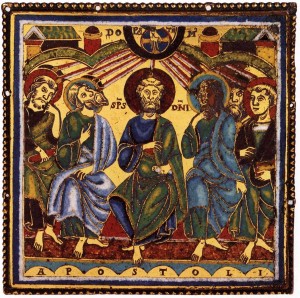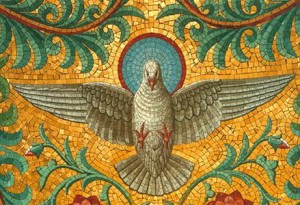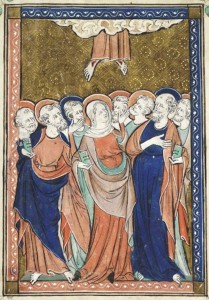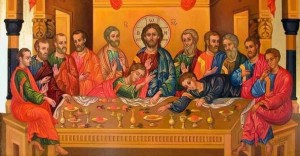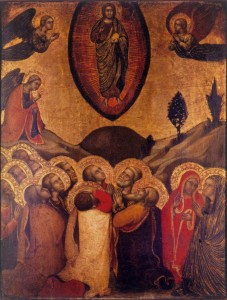 The Church celebrates this week the glorious feast of the Ascension of our Lord. The feast was celebrated on Thursday and today, so that as many people can participate as possible, we celebrate what is called the External Solemnity of the feast. It is important however not to loose sight of the fact that Our Lord, in fact, ascended on a Thursday, because it isn’t simply a random detail. On the one hand, it would seem that this feast marks the end of our Lord’s ministry, coming as it does at the end of his earthly life. (This is the symbolism of the Paschal Candle, which since Easter has burned as a sign of Christ’s teaching presence after the Resurrection among his disciples during the 40 days of Easter, which we rather dramatically extinguish after the Gospel) However, at the Ascension our Lord’s ministry actually reaches its culmination rather than its conclusion; Christ ascends on a Thursday, because it was on Thursday, at the Last Supper, that he instituted both the new priesthood and the new sacrifice: the Holy Eucharist; On Ascension Thursday, we see most clearly that Christ, a priest according to the Order of Melchizedec, now serves as mankind’s high priest before the Father in heaven. The Epistle to the Hebrews goes so far as to say that Christ “now lives to make intercession for us” (Heb. 7:25). The very way that Jesus ascended into heaven speaks to this mystery.
The Church celebrates this week the glorious feast of the Ascension of our Lord. The feast was celebrated on Thursday and today, so that as many people can participate as possible, we celebrate what is called the External Solemnity of the feast. It is important however not to loose sight of the fact that Our Lord, in fact, ascended on a Thursday, because it isn’t simply a random detail. On the one hand, it would seem that this feast marks the end of our Lord’s ministry, coming as it does at the end of his earthly life. (This is the symbolism of the Paschal Candle, which since Easter has burned as a sign of Christ’s teaching presence after the Resurrection among his disciples during the 40 days of Easter, which we rather dramatically extinguish after the Gospel) However, at the Ascension our Lord’s ministry actually reaches its culmination rather than its conclusion; Christ ascends on a Thursday, because it was on Thursday, at the Last Supper, that he instituted both the new priesthood and the new sacrifice: the Holy Eucharist; On Ascension Thursday, we see most clearly that Christ, a priest according to the Order of Melchizedec, now serves as mankind’s high priest before the Father in heaven. The Epistle to the Hebrews goes so far as to say that Christ “now lives to make intercession for us” (Heb. 7:25). The very way that Jesus ascended into heaven speaks to this mystery.
In St Luke’s account of the Ascension we read: “Then he led them out as far as Bethany, and lifting up his hands he blessed them, he parted with them, and was carried up into heaven.” (Luke 24. 52). Blessing was something familiar to every first century Jew. Each day at morning and evening, as commanded in the Law of Moses, the Jewish priests celebrated the tamid, or “perpetual offering” that we read about in the Book of Exodus (Ex. 29:38-41). One group of priests placed a lamb, bread, and wine on the altar as another group of priests led the people in reciting the Ten Commandments and the Shema, followed by the singing of the psalm designated for that day of the week. The tamid concluded with the priests gathering on the steps of the Holy Place, extending their arms out toward the people and invoking the blessing the Lord entrusted to Moses and Aaron: “The LORD bless you and keep you: The LORD make his face to shine upon you, and be gracious to you: The LORD lift up his countenance upon you, and give you peace.” (Num. 6:24-26). (This is why during the time of Divine Service, no woman or layman is permitted in the sanctuary. Boys are the exception as they, like the prophet Samuel before them, are allowed to serve the priests at their duty at the altar).
When the apostles and other disciples saw Jesus begin to ascend into heaven, in the very act of blessing them, they understood that he was “climbing the steps” of the true Holy Place. Only one Jewish priest was allowed to enter the Holy of Holies at the time of the tamid, to burn incense before God’s earthly throne room, the Holy of Holies. And the only person who could enter the Holy of Holies was the high priest, and he did so only once a year on the Feast of Yom Kippur. When the apostles saw Jesus disappear into a “cloud,” an Old Testament symbol of God’s presence (Acts 1:9; Ex. 13:31-32, 24:16-18; Num. 9:15-23), they understood that Jesus had entered into the true Holy of Holies, the reality to which the Temple and the earthly Holy of Holies were but a symbol and a pre-figurement (Ex. 25:9, 40; Heb. 8:5).
The worship of the Old Covenant — the Temple and its many sacrifices — find their fulfillment in Christ’s priesthood: his Death, Resurrection, and Ascension (Heb. 10:1-7). Jesus continues to offer himself to the Father, in his humanity, just as he has from all eternity in his divinity. The Epistle to the Hebrews and the Book of Revelation show Jesus, the Lamb of God, making the true perpetual offering to the Father — himself, through the five glorious wounds of his Passion (Heb. 7:25, 9:24; Rev. 5:6-14). Jesus draws all of heaven, the angels and saints, and indeed us as well, into this great heavenly liturgy, causing them to offer themselves through, with, and in him (Rev. 4:6-5:14).
This is the same liturgy that breaks through to earth, upon our altars, in the Holy Mass, where the sacrifice of Calvary is renewed through the ministry of priests. Moreover, through the sacrament of Holy Orders, Christ presides, in persona Christi, in the person of his priests. As the fulfillment of Israel’s tamid, the bread and wine we offer are indeed trans-substantiated into the very Lamb, himself, body, soul and divinity. We receive Christ himself in Holy Communion, the same Christ who bodily entered into the glory of the Father. Our lives are thus com-penetrated by his and every part united to his sacrifice to the Father (1 Cor. 10:16-18; Rom. 12:1). And when our priests pronounce the blessing over us before sending us forth, (which is why the blessing at the traditional Mass is given at the altar steps by the way) it is Christ who blesses — the same Christ who blessed the apostles before sending them out to convert the world.
We now prepare to celebrate the great gift of the Holy Spirit to us, which Christ promised at his Ascension, the Spirit of Truth who leads us into all truth, so that we too may take our part in converting the world. To fully receive that blessing — the Pentecostal grace Christ poured out upon the infant Church — we should dispose ourselves in the same way they did — faithful prayer and meditation upon Scripture, in the company of the Blessed Mother (Luke 24:49; Acts 1:14-15). These are very holy days, and indeed busy ones, but we should strive to recall the greater mysteries and then to live them as fully as possible. In Christ even something as unimportant as a Thursday takes on new meaning in our lives.
R. Dom Bede Price, monk of St Louis Abbey
Sermon for the Ascension 2016
Rector, Oratory of Ss. Gregory and Augustine

